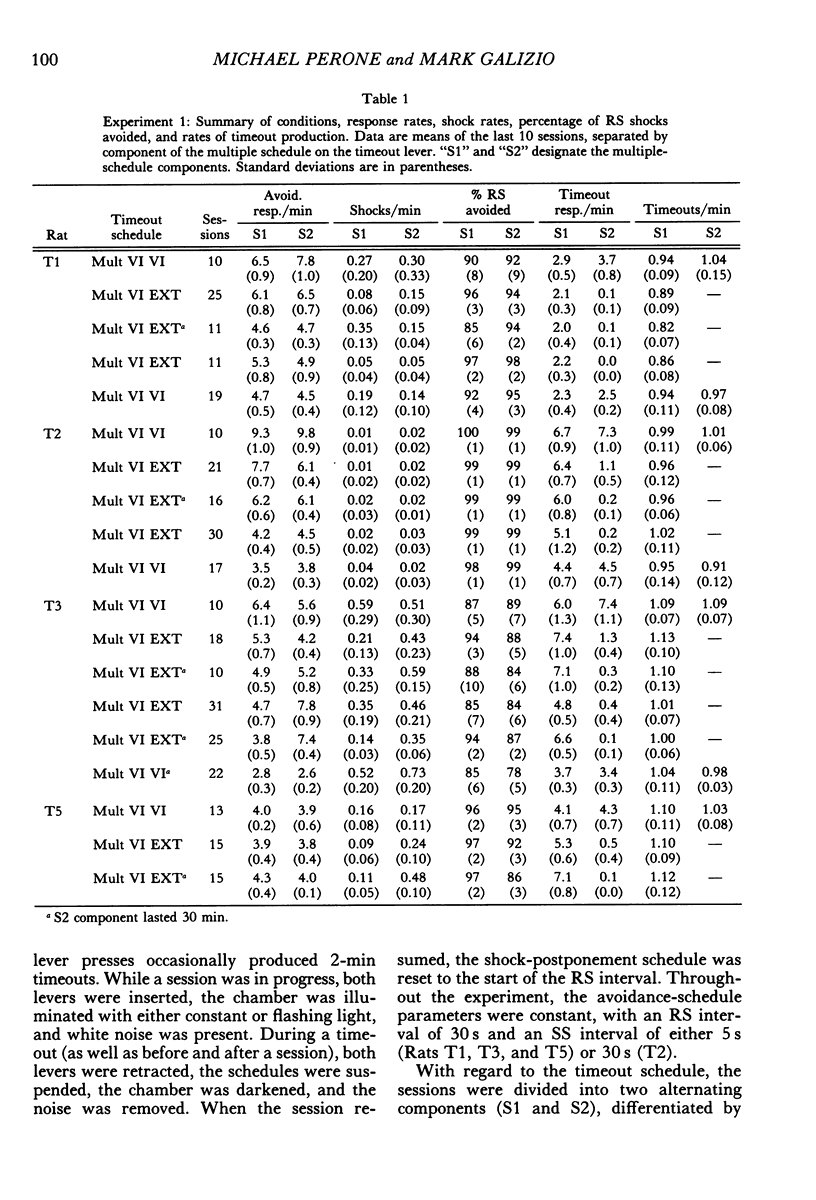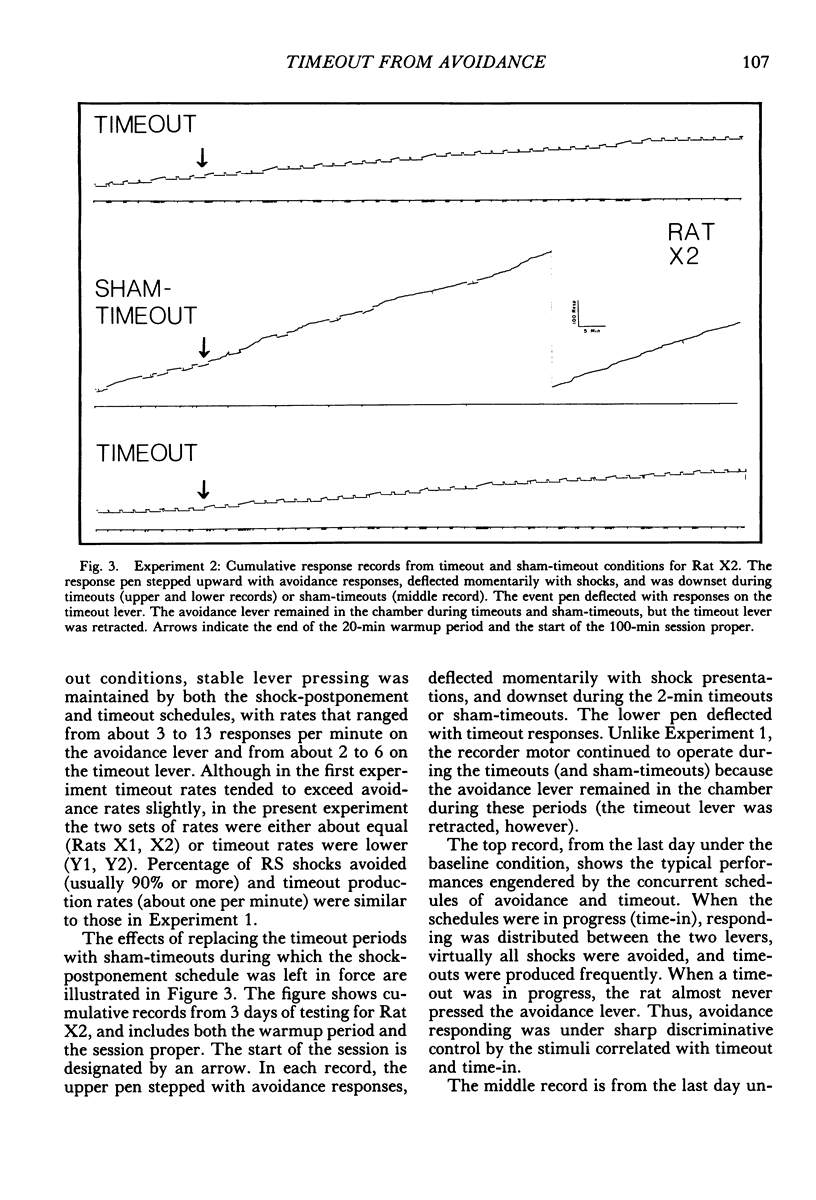Abstract
Rats were trained on concurrent schedules in which pressing one lever postponed shock and pressing the other occasionally produced a 2-min timeout during which the shock-postponement schedule was suspended and its correlated stimuli were removed. Throughout, the shock-postponement schedule maintained proficient levels of avoidance. Nevertheless, in Experiment 1 responding on the timeout lever was established rapidly, was maintained at stable levels on variable-interval schedules, was extinguished by withholding timeout, was reestablished when timeout was reintroduced, and was brought under discriminative control with a multiple variable-interval extinction schedule of timeout. These results are in contrast with Verhave's (1962) conclusion that timeout is an ineffective reinforcer when presented to rats on intermittent schedules. In Experiment 2 the consequence of responding on the timeout lever was altered so that the shock-postponement schedule remained in effect even though the stimulus conditions associated with timeout were produced for 2 min. Responding extinguished, indicating that suspension of the shock-postponement schedule, not stimulus change, was the source of reinforcement. By establishing the reinforcing efficacy of timeout with standard variable-interval schedules, these experiments illustrate a procedure for studying negative reinforcement in the same way as positive reinforcement.
Keywords: negative reinforcement, shock-postponement schedule, timeout from avoidance, variable-interval schedules, extinction, multiple schedules, sensory reinforcement, lever press, rats
Full text
PDF
















Selected References
These references are in PubMed. This may not be the complete list of references from this article.
- Appel J. B. The Aversive Control of an Operant Discrimination. J Exp Anal Behav. 1960 Jan;3(1):35–47. doi: 10.1901/jeab.1960.3-35. [DOI] [PMC free article] [PubMed] [Google Scholar]
- Baron A., Dewaard R. J., Lipson J. Increased reinforcement when timeout from avoidance includes access to a safe place. J Exp Anal Behav. 1977 May;27(3):479–494. doi: 10.1901/jeab.1977.27-479. [DOI] [PMC free article] [PubMed] [Google Scholar]
- Baron A., Trenholme I. A. Response-dependent and response-independent timeout from an avoidance schedule. J Exp Anal Behav. 1971 Jul;16(1):123–131. doi: 10.1901/jeab.1971.16-123. [DOI] [PMC free article] [PubMed] [Google Scholar]
- Baum W. M. The correlation-based law of effect. J Exp Anal Behav. 1973 Jul;20(1):137–153. doi: 10.1901/jeab.1973.20-137. [DOI] [PMC free article] [PubMed] [Google Scholar]
- CATANIA A. C. Behavioral contrast in a multiple and concurrent schedule of reinforcement. J Exp Anal Behav. 1961 Oct;4:335–342. doi: 10.1901/jeab.1961.4-335. [DOI] [PMC free article] [PubMed] [Google Scholar]
- De Villiers P. A. Reinforcement and response rate interaction in multiple random-interval avoidance schedules. J Exp Anal Behav. 1972 Nov;18(3):499–507. doi: 10.1901/jeab.1972.18-499. [DOI] [PMC free article] [PubMed] [Google Scholar]
- De Villiers P. A. The law of effect and avoidance: a quantitative relationship between response rate and shock-frequency reduction. J Exp Anal Behav. 1974 Mar;21(2):223–235. doi: 10.1901/jeab.1974.21-223. [DOI] [PMC free article] [PubMed] [Google Scholar]
- Dewaard R. J., Galizio M., Baron A. Chained schedules of avoidance: Reinforcement within and by avoidance situations. J Exp Anal Behav. 1979 Nov;32(3):399–407. doi: 10.1901/jeab.1979.32-399. [DOI] [PMC free article] [PubMed] [Google Scholar]
- Dinsmoor J. A. Escape, avoidance, punishment: where do we stand? J Exp Anal Behav. 1977 Jul;28(1):83–95. doi: 10.1901/jeab.1977.28-83. [DOI] [PMC free article] [PubMed] [Google Scholar]
- FLESHLER M., HOFFMAN H. S. A progression for generating variable-interval schedules. J Exp Anal Behav. 1962 Oct;5:529–530. doi: 10.1901/jeab.1962.5-529. [DOI] [PMC free article] [PubMed] [Google Scholar]
- Findley J. D., Ames L. L. A note on time out from avoidance with the chimpanzee. J Exp Anal Behav. 1965 Nov;8(6):419–423. doi: 10.1901/jeab.1965.8-419. [DOI] [PMC free article] [PubMed] [Google Scholar]
- Galizio M., Perone M., Spencer B. A. Variable interval schedules of timeout from avoidance: effects of ethanol, naltrexone, and CGS 8216. Pharmacol Biochem Behav. 1986 Aug;25(2):439–448. doi: 10.1016/0091-3057(86)90021-3. [DOI] [PubMed] [Google Scholar]
- Herrnstein R. J., Hineline P. N. Negative reinforcement as shock-frequency reduction. J Exp Anal Behav. 1966 Jul;9(4):421–430. doi: 10.1901/jeab.1966.9-421. [DOI] [PMC free article] [PubMed] [Google Scholar]
- Herrnstein R. J. Method and theory in the study of avoidance. Psychol Rev. 1969 Jan;76(1):49–69. doi: 10.1037/h0026786. [DOI] [PubMed] [Google Scholar]
- Hineline P. N. Aversive control: A separate domain? J Exp Anal Behav. 1984 Nov;42(3):495–509. doi: 10.1901/jeab.1984.42-495. [DOI] [PMC free article] [PubMed] [Google Scholar]
- Logue A. W., De Villiers P. A. Matching in concurrent variable-interval avoidance schedules. J Exp Anal Behav. 1978 Jan;29(1):61–66. doi: 10.1901/jeab.1978.29-61. [DOI] [PMC free article] [PubMed] [Google Scholar]
- Mellitz M., Hineline P. N., Whitehouse W. G., Laurence M. T. Duration-reduction of avoidance sessions as negative reinforcement. J Exp Anal Behav. 1983 Jul;40(1):57–67. doi: 10.1901/jeab.1983.40-57. [DOI] [PMC free article] [PubMed] [Google Scholar]
- Norman W. D., McSweeney F. K. Matching, contrast, and equalizing in the concurrent lever-press responding of rats. J Exp Anal Behav. 1978 May;29(3):453–462. doi: 10.1901/jeab.1978.29-453. [DOI] [PMC free article] [PubMed] [Google Scholar]
- SIDMAN M. Avoidance conditioning with brief shock and no exteroceptive warning signal. Science. 1953 Aug 7;118(3058):157–158. doi: 10.1126/science.118.3058.157. [DOI] [PubMed] [Google Scholar]
- SIDMAN M. Time out from avoidance as a reinforcer: a study of response interaction. J Exp Anal Behav. 1962 Oct;5:423–434. doi: 10.1901/jeab.1962.5-423. [DOI] [PMC free article] [PubMed] [Google Scholar]
- Schrot J., Boren J. J., Moerschbaecher J. M. Sequential reacquisition as a function of timeout from avoidance. J Exp Anal Behav. 1976 May;25(3):303–310. doi: 10.1901/jeab.1976.25-303. [DOI] [PMC free article] [PubMed] [Google Scholar]
- Schrot J., Boren J. J., Moerschbaecher J. M., Simoes Fontes J. C. Effects of d-amphetamine and cocaine on repeated acquisition with timeout from avoidance. Pharmacol Biochem Behav. 1978 Nov;9(5):659–663. doi: 10.1016/0091-3057(78)90218-6. [DOI] [PubMed] [Google Scholar]
- VERHAVE T. The functional properties of a time out from an avoidance schedule. J Exp Anal Behav. 1962 Oct;5:391–422. doi: 10.1901/jeab.1962.5-391. [DOI] [PMC free article] [PubMed] [Google Scholar]


